

 |
Search the Site with

|
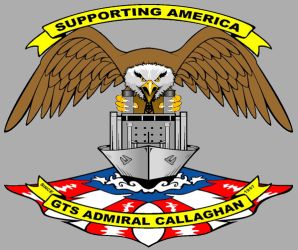 | 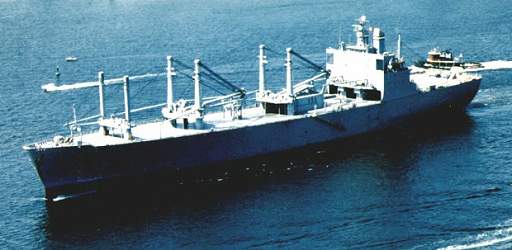 |
Initially built for the American Export Isbrandtsen Lines shipping company, the ship was delivered in 1967 and subsequently chartered by the Military Sea Transportation Service (later Military Sealift Command). Named after Admiral William M. Callaghan - the first commander of the MSTS - the ship was not assigned a hull number nor was it entered in the Naval Vessel Register. Transfered to the MARAD Ready Reserve Force on December 10, 1986, the ADM. WM. M. CALLAGHAN was later designated T-AKR 1001. Today, the ship is berthed at Alameda, Calif., capable of being fully activated within 5 days.
| General Characteristics: | Keel laid: December 20, 1966 |
| Launched: October 17, 1967 | |
| Delivered: December 19, 1967 | |
| Builder: Sun Shipbuilding and Dry Dock Co., Chester, PA. | |
| Propulsion system: two LM2500 gas turbines | |
| Propellers: two | |
| Length: 694.5 feet (211.7 meters) | |
| Beam: 91.9 feet (28 meters) | |
| Draft: 28.9 feet (8.8 meters) | |
| Displacement: approx. 24,500 tons full load | |
| Speed: 21+ knots | |
| Aircraft: none | |
| Armament: none | |
| Capacity: up to 750 vehicles and cargo | |
| Crew: approx. 33 (when activated) | |
| Homeport: Alameda, Calif. |
Crew List:
This section contains the names of sailors who served aboard GTS ADM. WM. M. CALLAGHAN. It is no official listing but contains the names of sailors who submitted their information.
About the Ship's Name:
William McCombe Callaghan - born on 8 August 1897 to Charles William and Rose [Wheeler] Callaghan, of Oakland, Calif., - was appointed a midshipman from the Sixth District of California on 11 June 1915. Detached from the U.S. Naval Academy on 6 June 1918, the graduation of the Class of 1919 accelerated because of the World War, he reported to WISCONSIN (BB 9) on 21 June, and was commissioned ensign the same day, to rank from 7 June.
Ordered to duty with the Destroyer Force, Ens. Callaghan was detached from the battleship at Queenstown, Ireland, on 12 July 1918, and reported on 5 August to STEVENS (DD 86). He was appointed lieutenant (junior grade) (temporary) on 25 October, to rank from 21 September. Detached from STEVENS on 15 December, he joined ALLEN (DD 66) the same day. Transferred to CHAMPLIN (DD 104) for temporary duty on 28 July 1919, Callaghan was detached from that ship upon her arrival on the west coast of the U.S., to proceed to the Mare Island Navy Yard, Vallejo, Calif., where he helped fit out HAMILTON (DD 141) (July-November 1919), after which time he served as her engineer officer, being formally detached from temporary duty in CHAMPLIN on 22 August 1919.
Lt. (j.g.) Callaghan helped fit out NICHOLAS (DD 311), building at the Bethlehem Shipbuilding Corp., San Francisco, Calif., then, after her being commissioned on 23 November 1920, served as her engineer officer. For almost two and a half years, Callaghan then served in a succession of destroyers: DENT (DD 116) (4 January -10 June 1921), FARQUHAR (DD 304) (18 June-10 August 1921), TWIGGS (DD 127) (12 August-11 October 1921) (during which tour he wed Helen Louise Brunett of Rockville, Md., on 24 August 1921) and SLOAT (DD 316) (11 October-9 June 1923). During that time, he was commissioned regular lieutenant (j.g.) (25 August 1921) while he was performing engineering duty in TWIGGS, and he was commissioned a regular lieutenant four days before Christmas of 1922, to rank from 3 June.
Detached from SLOAT on 9 June 1923, Lt. Callaghan reported back to the Naval Academy on 25 June to attend the Postgraduate School, for instruction in engineering, schooling that included temporary duty at the Philadelphia (Pa.) Navy Yard; Columbia University, New York City, N.Y.; and the Westinghouse Electric & Manufacturing Co, Pittsburgh, Pa. Detached on 3 September 1925, Callaghan then took passage in the store ship BRIDGE (AF 1) for the voyage to Guantanamo Bay, Cuba, where he joined the light cruiser CONCORD (CL 10) on 19 October 1925.
Following a shore tour at the Bureau of Engineering, in Washington, D.C. (24 November 1928 – 2 May 1930), Lt. Callaghan returned to sea duty soon thereafter. Detached from the bureau, he reported to SARATOGA (CV 3) on 5 June 1930, and became her assistant engineer officer on 30 December 1931. While serving in the carrier, Callaghan received a promotion to ad interim lieutenant commander on 1 November 1932 (to rank from 2 August), then to regular lieutenant commander on 30 January 1933 (to rank from 1 July 1932). Detached from SARATOGA on 28 May 1933, Lt. Cmdr. Callaghan returned to the Naval Academy, where he served as an instructor (30 June 1933–27 May 1936).
Callaghan returned to sea duty, reporting to assume command of REUBEN JAMES (DD 245) on 15 June 1936. Detached from that destroyer on 5 March 1938, he became executive officer of the transport HENDERSON (AP 1) 12 days later, on 17 March, and while serving in that ship received promotion to ad interim commander on 23 September 1938, to rank from 23 June, and to regular commander on 23 January 1939, to rank from 23 June 1938. Detached from HENDERSON on 26 May 1939, Cmdr. Callaghan received orders to report to the office of the Chief of Naval Operations (CNO), in Washington, to serve in the Ships’ Movement Division, and did so on 6 June 1939, three months before war broke out in Europe with the German invasion of Poland.
Detached on 8 August 1941, Cmdr. Callaghan reported to the American Embassy in London, England, two days later, and served a brief tour as a naval observer there (10 August-9 September), reporting back to the office of the CNO on 11 September. He continued on duty in Washington through U.S. entry into World War II with the attack on Oahu by Japanese carrier planes on 7 December 1941, and into the first summer of the war, at which time he received orders on 6 July 1942 to report to Adm. Chester W. Nimitz, Commander in Chief, Pacific Fleet (CinCPac), for duty on his staff. A little over two months later, on 11 September, Callaghan received appointment as captain for temporary service, to rank from 17 June. He received the Legion of Merit for his “exceptionally meritorious conduct as Assistant War Plans Officer for Logistics and Assistant Logistics Officer” for the period between 10 July 1942 and 1 May 1944.
Service in that capacity served as a prelude to Callaghan’s receiving command of the new battleship MISSOURI (BB 63), the third ship of the IOWA (BB 61) - class.
Ordered to “temporary duty [in] connection [with] fitting out” the new warship, he assumed command when MISSOURI was commissioned on 11 June 1944. Arriving in the forward areas in February 1945, the battleship provided support for the carriers that launched the first mass air strike against the Japanese home islands (16-17 February), furnished close support for the carriers as they operated against Iwo Jima, against Tokyo (25-27 February), and reprised her work with the carriers at Iwo Jima (1 March). Soon thereafter, MISSOURI took part in a two-day sweep off the Japanese coast line, and the initial bombardment of Okinawa (24 March).
On April 11, 1945, USS MISSOURI was struck by a kamikaze off the coast of Okinawa. The damage was minor, and no one died aboard this battleship except the Japanese pilot, Setsuo Ishino, whose body was recovered. Captain Callaghan insisted that the young Japanese airman had done his job to the best of his ability and with honor and deserved a military funeral. The following day, April 12, 1945, the pilot was given a military funeral at sea.
Callaghan commanded MISSOURI until 15 May 1945 (relieved at Ulithi by Capt. Stuart S. Murray) and was promoted to rear admiral (for temporary service) two days later, on 17 May. Returning to duty on CinCPac’s staff (May-July 1945), he then journeyed back to Washington and the Navy Department, becoming Assistant Chief of Naval Operations (Transportation) and Chief of the Naval Transportation Service (NTS), during which time the NTS returned nearly 3,500,000 servicemen from Pacific areas for demobilization after the cessation of hostilities. He then served as Commander, Training Command, Atlantic Fleet (13 August 1948). Becoming Commander, Military Sea Transportation Service (MSTS) on 15 September 1949, he served in that capacity, receiving promotion to vice admiral on 11 April 1951, until December of 1952.
After serving as Commander, Amphibious Force, Pacific Fleet (December 1952 – March 1954), and Commander, Naval Forces, Far East (March 1954 – November 1956), Vice Admiral Callaghan closed out his naval career as Commander Western Sea Frontier (November 1956 – March 1957). He retired with the permanent rank of rear admiral on 1 March 1957, but was advanced to vice admiral on the retired list by Act of Congress.
Vice Admiral Callaghan died at Bethesda National Naval Medical Center (NNMC) on 8 July 1991 following a stroke.
GTS ADM. WM. M. CALLAGHAN Image Gallery:
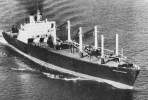 |
The photos below were taken by me and show the ADM. WM. M. CALLAGHAN berthed at Alameda, Calif., on July 18, 2006.
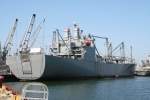 | 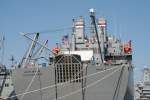 |
The photos below were taken by me and show the ADM. WM. M. CALLAGHAN berthed at Alameda, Calif., on March 28, 2010.
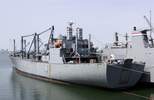 | 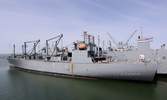 | 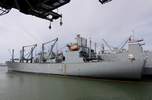 |
The photos below were taken by me and show the ADM. WM. M. CALLAGHAN berthed at Alameda, Calif., on March 19, 2012.
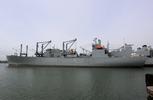 | 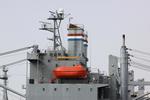 |
 Back to Vehicle Cargo Ships.
Back to Vehicle Cargo Ships.  Back to ships list.
Back to ships list.  Back to selection page.
Back to selection page.  Back to 1st page.
Back to 1st page.